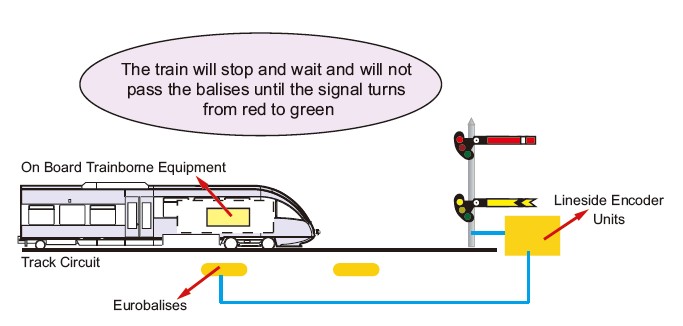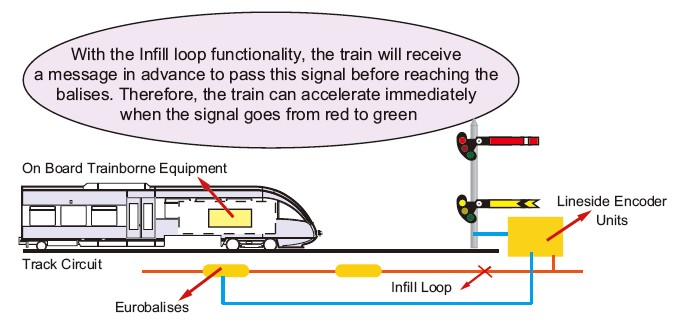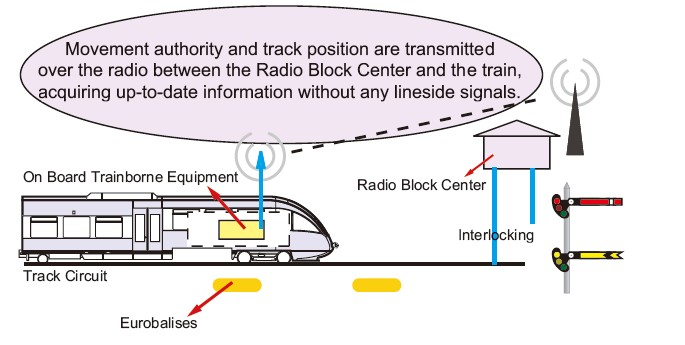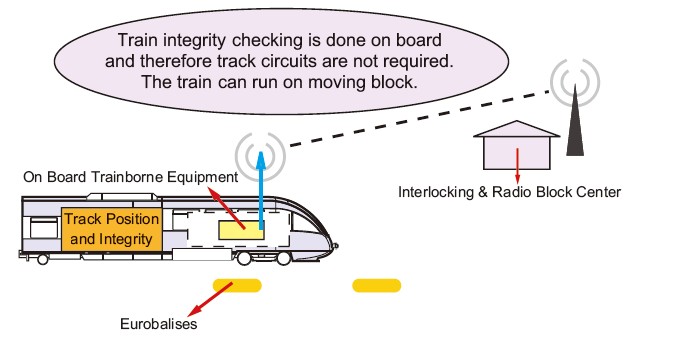Q:What is ERTMS?
A:The European Rail Traffi c Management System has been defi ned in 3 levels
ERTMS Level 1:
A. Eurobalises
- Overlay to Existing Signalling System.
- Movement Authorities through Eurobalise.
- Train Integrity & Position by Track Circuit.
B. Eurobalises with infill (Euroloop or radio or extra balises)
- Overlay to Existing Signalling System.
- Movement Authorities through Eurobalise.
- Train Integrity & Position by Track Circuit.
ERTMS Level 1 is a Train Control System based on track-to-train communication by an intermittent system. The
system includes Lineside Encoder Units (LEU) which is designed to acquire traffic information and convert this into
conditioning messages to be sent to the balise for subsequent processing by the On Board equipment. Each LEU can
command up to 4 balises. Each Encoder cabinet can house up to 8 LEUs. The maximum distance between balises is
5 km. Connection to Computer Based Interlocking is either through a safety protocol stack based on “Profi bus”, or
HDLC proprietary serial link. Purpose of the Eurobalise is to transmit a message to the On-Board equipment in order to
advise the driver and the On-Board ATP processing unit about the train positioning and the conditions of the track and
traffi c ahead, and hence take the appropriate actions for train speed and for the protection of the train itself, passengers
and infrastructure alike. LEUs and Eurobalises are linked through a suitable connection cable. The On Board equipment
serves to calculate the dynamic speed profi le, select the most restrictive speed value, compare the train's actual speed
with the permitted speed and, if necessary, perform brake application. Radio In-fi ll is a functionality that can be optionally
added to the ERTMS Level 1 in order to increase the performance of the line. Purpose of the Radio Infill Unit is to
transmit the message corresponding to the Eurobalise in advance with respect to the Eurobalise placed at the signal. In
this way, a train approaching a signal at stop can revoke braking as soon as the signal clears without waiting to get to the
signal itself. The In-fi ll message is transmitted via radio using GSM-R and Euroradio safety protocols, as in ERTMS Level
2. The use of radio allows a continuous infi ll coverage at unlimited distance from the signal.
ERTMS Level 2: Eurobalises + Euroradio (GSM-R) + Radio Block Centre (RBC)
- No more Trackside Signals Required.
- Movement Authorities through GSM-R.
- Train Position via Eurobalise.
ERTMS Level 2 is a Train Control System based on data communications between the Centralized Block Centre
and the trains, via a radio system. ETCS Level 2 brings the introduction of radio transmission for railway signalling i.e.
GSM-R (Global Standard of Mobile Communication-Rail) in the frequency range of 900 MHz. In this case, the Eurobalise
acts as intermittent transmission device, mainly for location reference. The Radio Block Centre (RBC) is wayside
redundant management system designed to provide information continuously to each train and knows from trains their
positions; it receives track circuits and route status information from the Automatic Block System and from Interlockings.
ETCS Level 2 combines many advantages as follows:
- Long term compatibility with other European railways by use of Eurobalise beacons;
- On-board signalling by use of radio transmission with the GSM-R protocol;
- Minimum amount of devices in the track, what reduce time and costs for track maintenance.
ERTMS Level 3: Eurobalises + Euroradio (GSM-R) + Radio Block Centre (RBC)
- Movement Authorities through GSM-R.
- Train Position via Eurobalise.
- Train Integrity Onboard. Moving Block.
There are only a few players providing the very fi rst High Speed Line in commercial service running solely on an
ERTMS Level 2 system. Beside Europe, countries like China and India also embracing this advanced signalling system.
Thousands of kms of ERTMS Level 1 lines are in operation or under construction also.




